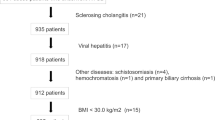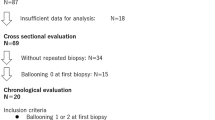Abstract
OBJECTIVE: To examine the factors associated with liver steatosis in severely obese subjects and to test the potential reversibility of fatty liver after weight loss.
DESIGN: Retrospective clinical study.
SUBJECT: 528 obese patients before bariatric surgery and 69 obese subjects of the initial cohort evaluated before and 27±15 months after gastroplasty.
MEASUREMENTS: Fatty deposition (scored as mild, moderate or severe) and inflammatory changes were evaluated in liver biopsies; clinical (body mass index (BMI), age, gender, duration of obesity) and biological (glucose, triglycerides, liver enzymes) parameters were related to histological findings.
RESULTS: 74% of the 528 biopsies showed fatty change, estimated as mild in 41% of cases, moderate in 32% and severe in 27%. The prevalence of steatosis was significantly higher in men than in women (91% vs 70%, P=0.001) and in patients with impaired glucose tolerance or type 2 diabetes compared with nondiabetics (89% vs 69% P=0.001). The severity of the steatosis was associated with BMI (P=0.002) but not with the duration of obesity or the age of the patient. When compared with patients without fatty change, those with liver steatosis had significantly higher fasting plasma glucose (5.5 mmol/l vs 5.1 mmol/l, P=0.007) and triglycerides (1.8 mmol/l vs 1.3 mmol/l, P=0.002). Mean serum liver enzyme activities (alkaline phosphatase, aspartate aminotransferase (AST), alanine aminotransferase (ALT) and gamma-glutamyl-transpeptidase (γGT) were significantly (P<0.001) increased in patients with fatty change but remained within laboratory reference values. In the 69 patients who have been evaluated after a marked weight reduction (−32±19 kg), 45% of the biopsies were considered as normal (vs 13% before, P<0.001) while pure fatty change was still observed in 38% of the patients (vs 83% before, P=0.001). However, the severity of the steatosis was significantly (P<0.001) reduced (mild: 62% vs 21%; moderate: 23% vs 37%; severe: 15% vs 42%). In addition, a significant increase of hepatitis was observed in 26% of the biopsies (vs 14% before, P<0.05).
CONCLUSIONS: Liver steatosis in obese subjects is associated with men, diabetic status, BMI, higher fasting glucose and hypertriglyceridaemia. Postgastroplasty weight loss reduces liver steatosis, but seems to increase the incidence of inflammatory lobular hepatitis.
This is a preview of subscription content, access via your institution
Access options
Subscribe to this journal
Receive 12 print issues and online access
$259.00 per year
only $21.58 per issue
Buy this article
- Purchase on Springer Link
- Instant access to full article PDF
Prices may be subject to local taxes which are calculated during checkout
Similar content being viewed by others
Author information
Authors and Affiliations
Rights and permissions
About this article
Cite this article
Luyckx, F., Desaive, C., Thiry, A. et al. Liver abnormalities in severely obese subjects: Effect of drastic weight loss after gastroplasty. Int J Obes 22, 222–226 (1998). https://doi.org/10.1038/sj.ijo.0800571
Received:
Revised:
Accepted:
Published:
Issue Date:
DOI: https://doi.org/10.1038/sj.ijo.0800571
Keywords
This article is cited by
-
Bariatric Surgery in NAFLD
Digestive Diseases and Sciences (2022)
-
Impact of Nonalcoholic Steatohepatitis on the Outcome of Patients Undergoing Roux-en-Y Gastric Bypass Surgery: a Propensity Score–Matched Analysis
Obesity Surgery (2022)
-
First Case Report of Fulminant Hepatitis After Laparoscopic Sleeve Gastrectomy Associated with Concomitant Maximal Therapeutic Dose of Acetaminophen Use, Protein Calorie Malnutrition, and Vitamins A and D, Selenium, and Glutathione Deficiencies
Obesity Surgery (2021)
-
Malnutrition and Alcohol in Patients Presenting with Severe Complications of Cirrhosis After Laparoscopic Bariatric Surgery
Obesity Surgery (2021)
-
Evaluation of anti-obesity potential of aqueous extract of Achyranthes aspera Linn. in high fat diet induced obese rats
Clinical Phytoscience (2020)



